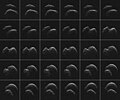 Radar image of 2014 JO25 taken at Goldstone on 19 Apr 2017 | |
| Discovery [1] | |
|---|---|
| Discovered by | Mount Lemmon Srvy. |
| Discovery site | Mount Lemmon Obs. (first observation only) |
| Discovery date | 5 May 2014 |
| Designations | |
| 2014 JO25 | |
| NEO · Apollo · PHA [1] [2] | |
| Orbital characteristics [1] | |
| Epoch 23 March 2018 (JD 2458200.5) | |
| Uncertainty parameter 0 | |
| Observation arc | 6.02 yr (2,200 days) |
| Aphelion | 3.8996 AU |
| Perihelion | 0.2364 AU |
| 2.0680 AU | |
| Eccentricity | 0.8857 |
| 2.97 yr (1,086 days) | |
| 125.06° | |
| 0° 19m 53.04s / day | |
| Inclination | 25.261° |
| 30.637° | |
| 49.571° | |
| Earth MOID | 0.0110 AU (4.3 LD) |
| Mercury MOID | 0.0210 AU [2] |
| Venus MOID | 0.0412 AU [2] |
| Physical characteristics | |
| 0.72 km (est. at 0.20) [3] 0.818 km (calculated) [4] | |
| 4.531 h [4] | |
| 0.20 (assumed) [4] | |
| S (assumed) [4] | |
| 17.8 [2] [4] [1] | |
(671294) 2014 JO25 is a near-Earth asteroid. It was discovered in May 2014 by astronomers at the Catalina Sky Survey near Tucson, Arizona - a project of NASA's NEO (Near Earth Object) Observations Program in collaboration with the University of Arizona.






